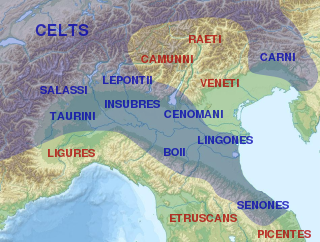Related Research Articles

The Taurini were a Celto-Ligurian tribe dwelling in the upper valley of the river Po, around present-day Turin, during the Iron Age and the Roman period.
The Viducassēs were a Gallic tribe dwelling in the modern Calvados department during the Iron Age and the Roman period.

The Petrocorii were a Gallic tribe dwelling in the present-day Périgord region, between the Dordogne and Vézère rivers, during the Iron Age and the Roman period.
The Medulli were a Gallic tribe dwelling in the upper valley of Maurienne, around present-day Modane (Savoie), during the Iron Age and Roman period.
The Alauni were a Gallic tribe dwelling around the lake Chiemsee during the Roman period.
The Latobici or Latovici were a Celtic tribe dwelling in Pannonia Superior, around present-day Drnovo (Slovenia), during the Roman period.

The Bituriges Vivisci were a Gallic tribe dwelling near modern-day Bordeaux during the Roman period. They had a homonym tribe, the Bituriges Cubi in the Berry region, which could indicate a common origin, although there is no direct of evidence of this.
The Segusini were a Gallic tribe dwelling around present-day Susa, in the Alpes Cottiae, during the Iron Age.

The Nitiobroges were a Gallic tribe dwelling on the middle Garonne river, around their chief town Aginnon, during Iron Age and the Roman period.
The Avantici were a small Gallic tribe dwelling around present-day Gap, in the western part of the modern Hautes-Alpes department, during the Roman period.
The Sentii were a small Gallic tribe dwelling around present-day Senez, in southeastern France, during the Roman era.
The Suetrii or Suetri were a Gallic tribe dwelling around present-day Castellane (Alpes-de-Haute-Provence) during the Iron Age and the Roman period.
The Aneuniates were a small Gallic tribe dwelling near Lake Como, around present-day Samolaco, during the Roman period.
The Ambisontes were a Gallic tribe dwelling in the upper Salzach valley during the Roman period.
The Vennones or Vennonetes were a Rhaetian tribe dwelling in the northern Alps, between Chur and Lake Constance, during the Iron Age and the Roman era.
The Rucinates or Rucantii were a Gallic tribe dwelling in near the confluence of the Isar and Danube rivers during the Roman period.
The Ambilici were a Gallic tribe dwelling in the valley of Gail river during the Roman period.
The Licates were a Gallic tribe dwelling in the upper valley of the Lech river during the Iron Age and the Roman period.
The Belouni were a Gallic tribe dwelling on the eastern shore of Lake Garda during the Roman period.
The Libicii were a Gallic tribe dwelling in the Camargue region during the Iron Age.
References
- ↑ Ptolemy. Geōgraphikḕ Hyphḗgēsis, 2:13:2.
- ↑ AE 1954, 241 and 100.
- 1 2 Falileyev 2010, s.v. Ambidrauoi.
- ↑ Talbert 2000, Map 19: Raetia.
Bibliography
- Falileyev, Alexander (2010). Dictionary of Continental Celtic Place-names: A Celtic Companion to the Barrington Atlas of the Greek and Roman World. CMCS. ISBN 978-0955718236.
- Talbert, Richard J. A. (2000). Barrington Atlas of the Greek and Roman World. Princeton University Press. ISBN 978-0691031699.
